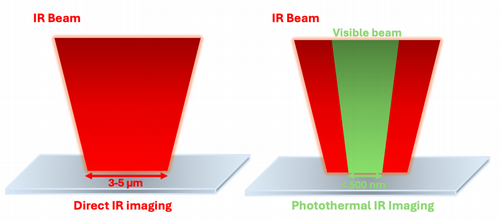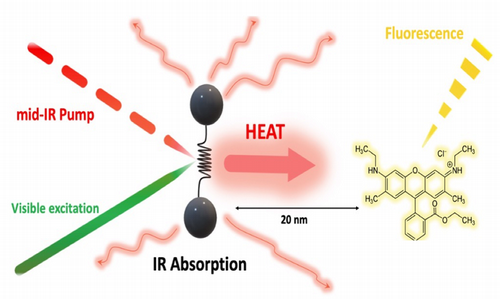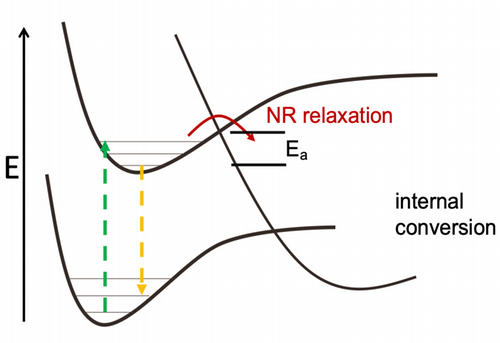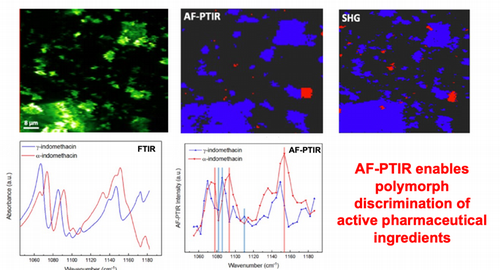Mid-infrared spectral imaging with fluorescence photothermal detection
Photothermal mid-IR techniques have emerged as a useful tool to overcome the inherent low resolution of IR microscopy due to the diffraction limit of mid-IR light. Optically detected photothermal mid-IR (O-PTIR) microscopy was developed as a method capable of measuring virational absorption spectra by detecting subtle changes in refractive index caused by thermal expansion. It has been demonstrated to reach sub-diffraction spatial resolution when imaging polymeric beads and has shown mapping of the distribution of components within a drug tablet.

However, O-PTIR faces numerous challenges, namely (a) refractive index is a weak function of temperature, changing by ~0.01% per °C for water, (b) biased by scattering which complicates quantiative spectral analysis, and (c) produces a nontrivial 3D point spread function complicating image interpretability.
An alternative approach based on measuring temperature-induced changes in fluorescence quantum efficiency has been developed by the Simpson group and independently by Cheng and coworkers (Boston University). In this scheme, the fluorescence emission is used as a local temperature-reporter. Increases in temperature produced reductions in quantum yield, enabling quantification of absorbption localized to the resolution limit of fluorescence microscopy.


Fluorescence-detected photothermal mid-IR (F-PTIR) microscopy was shown to achieve at least an order of magnitude (~100-fold) signal to noise improvement over conventional O-PTIR. Our group has recently also demonstrated proof-of-concept label-free F-PTIR spectroscopy of biological active pharmaceutical ingredients. Due to the dependence on fluorescence, the point-spread function, and corresponding spatial resolution, is dictated by the point-spread function, and corresponding spatial resolution, is dictated by the point spread function describing fluorescence microscopy.

Current research involves developing F-PTIR instrumentation in terms of hardware, timing control, scanning methods, and detection schemes to expand the scope of use.
See our most recent publications below:
- Razumtcev, A.; Li, M.; Simpson, G.J.; Parts-per-Million Detection of Trace Crystal Forms Using AF-PTIR Microscopy. Analytical Chemistry 2022 94 (38), 13100-13107 DOI: 10.1021/acs.analchem.2c02358
-
Razumtcev, A.; Li, M.; Rong, J.; Teng, C.C.; Pfluegl, C.; Taylor, L.S.; Simpson, G.J. Label-Free Autofluorescence-Detected Mid-Infrared Photothermal Microscopy of Pharmaceutical Materials. Analytical Chemistry 2022 94 (17), 6512-6520 DOI: 10.1021/acs.analchem.1c05504
-
Li, M.; Razumtcev, A.; Yang, Y.; Liu, Y.; Rong, J.; Geiger, A.C.; Blanchard, R.; Pfluegl, C.; Taylor, L.S.; Simpson, G.J. Fluorescence-Detected Mid-Infrared Photothermal Microscopy. Journal of the American Chemical Society 2021 143 (29), 10809-10815 DOI: 10.1021/jacs.1c03269